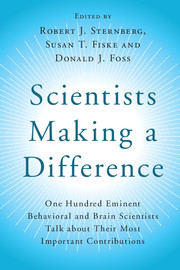 Scientists Making a Difference
Scientists Making a Difference from Section A - Motivation
Published online by Cambridge University Press: 05 August 2016
I have conducted research on many different topics, including personality, psychopathology, life satisfaction and subjective well-being, mate preferences and marital satisfaction, sleep, organizational behavior, attitudes, and values. To make progress in each of these areas, researchers have had to answer two basic questions. First, what basic concepts (known formally as constructs) do we need to study? Second, how do we measure these constructs? My most important scientific contribution is that I played a key role in supplying plausible answers to both of these questions in the domain of affect, which is the area of science that examines moods, feelings, and emotions.
Development of the Model
How I Became an Affect Researcher
My work in this area arose from an improbable series of events. Early in my fourth year of graduate school at the University of Minnesota, I started dating Lee Anna Clark, who was a student in the Clinical Psychology program (I was in the much smaller Personality Research program). When it was clear that our relationship was becoming serious, she informed me that she recently had received a Fulbright International Fellowship to conduct her dissertation research in Japan the following academic year (1979–1980). We eventually decided that we would get married and I then would take a year off from graduate school and accompany her to Japan for her Fulbright year.
I scheduled a meeting with my graduate advisor, Auke Tellegen, to break the news to him. I had some trepidation about this, because I expected him to react negatively to the news. However, he actually was pleased, as he saw this as an opportunity to test the cross-cultural replicability of a model he had developed. Most mood/emotion researchers at that time emphasized the importance of specific, “discrete” affective states, such as fear, sadness, anger, joy, and attentiveness. In contrast, Auke had collected data indicating that emotional experience was dominated by two broad and non-specific dimensions, which he labeled Negative Affect (i.e., the non-specific tendency to experience aversive emotional states such as anxiety, depression, and hostility) and Positive Affect (i.e., the tendency to experience pleasurable and rewarding states such as happiness, enthusiasm, and alertness).
To save this book to your Kindle, first ensure no-reply@cambridge.org is added to your Approved Personal Document E-mail List under your Personal Document Settings on the Manage Your Content and Devices page of your Amazon account. Then enter the ‘name’ part of your Kindle email address below. Find out more about saving to your Kindle.
Note you can select to save to either the @free.kindle.com or @kindle.com variations. ‘@free.kindle.com’ emails are free but can only be saved to your device when it is connected to wi-fi. ‘@kindle.com’ emails can be delivered even when you are not connected to wi-fi, but note that service fees apply.
Find out more about the Kindle Personal Document Service.
To save content items to your account, please confirm that you agree to abide by our usage policies. If this is the first time you use this feature, you will be asked to authorise Cambridge Core to connect with your account. Find out more about saving content to Dropbox.
To save content items to your account, please confirm that you agree to abide by our usage policies. If this is the first time you use this feature, you will be asked to authorise Cambridge Core to connect with your account. Find out more about saving content to Google Drive.